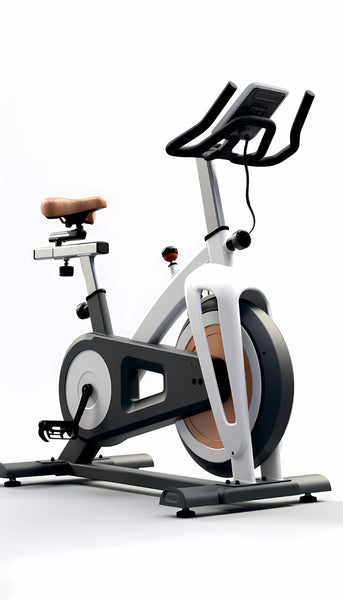World with so much in social media, coming up with new food cuisines and recipes, it's now getting difficult to take a lock to our tongue! But They say mind is everything…
And now you’re looking to take your fitness routine to the next level to balance this?
An exercise bike, also known as a spin bike or stationary bike, could be the perfect addition to your home gym. Not only are exercise bikes incredibly versatile, but research shows they offer a wide range of health benefits.
Whether you're hoping to torch calories, improve your cardiovascular health, or simply find a low-impact form of cardio, an exercise bike could be just what you need. In this blog, we'll dive into the top benefits of using an exercise bike.
Let's get started!
8 Benefits of Exercise Bikes

Exercise bikes offer a wealth of advantages, backed by solid scientific research. Here are eight key benefits you can expect:
1. Increased Calorie Burn
One of the primary draws of exercise bikes is their ability to help you torch calories. These machines engage the large muscle groups in your lower body, including your quadriceps, hamstrings, calves, and glutes. When these muscles are activated, they can burn a significant number of calories - potentially even continuing to do so for up to 14 hours after your workout.
Studies show that just 45 minutes of vigorous cycling can burn over 500 calories, with an additional 190 calories burned in the 14 hours following the workout. Of course, the exact number of calories you'll burn will depend on factors like your weight and workout intensity, but exercise bikes are undoubtedly an effective tool for weight loss.
2. Improved Body Composition and Heart Health
In addition to burning calories, exercise bikes can also help improve your body composition and heart health. One study found that 12 weeks of indoor cycling, combined with a low-calorie diet, led to decreases in BMI, total body mass, and fat percentage. Participants also experienced improvements in cholesterol and triglyceride levels.
Even just cycling alone, without dietary changes, was shown to have a positive impact on these important health markers. This suggests that exercise bikes can be a valuable tool for enhancing cardiovascular fitness and overall well-being.
3. Increased Muscle Strength and Endurance
Riding an exercise bike engages a variety of muscle groups, from your legs to your core. This helps to build strength and endurance in these key areas. You can further challenge your muscles by adjusting the resistance level, making your workouts more intense as you progress.
Many exercise bikes also feature moving handlebars, allowing you to activate your upper body as well. By standing up and gripping the handles during your ride, you'll work your arms, shoulders, and back in addition to your lower body.
4. Improved Cardiovascular Health
Aerobic exercises like cycling are fantastic for your heart health. Regular use of an exercise bike can help reduce your risk of heart disease, type 2 diabetes, and stroke, while also improving blood flow, blood pressure, and blood sugar management.
Even for individuals with existing conditions like metabolic syndrome, studies have shown that cycling, combined with dietary changes, can lead to significant improvements in various cardiovascular markers.
5. Low-Impact Cardio
One of the best things about exercise bikes is that they offer a low-impact form of cardio. Unlike running, where your joints bear the brunt of the impact with each step, cycling allows you to get your heart rate up without putting excessive stress on your knees, ankles, and hips.
This makes exercise bikes an excellent choice for individuals with joint pain or mobility issues, as well as those looking to reduce their risk of impact-related injuries.
6. Reduced Joint Pain
Speaking of joint pain, research suggests that cycling can help alleviate discomfort, particularly in the knees. One systematic review found that stationary bike users with osteoarthritis reported reduced joint pain and improved performance compared to those who didn't exercise.
Of course, it's always a good idea to consult your doctor before starting a new exercise routine, especially if you have any pre-existing conditions. However, the low-impact nature of exercise bikes makes them a promising option for those dealing with joint problems.
7. Customizable Intensity
One of the best things about exercise bikes is their versatility. With just a few taps of a button, you can adjust the resistance to make your workout as easy or as challenging as you'd like. This allows you to tailor your rides to your fitness level and goals, whether you're looking for a leisurely spin or a high-intensity interval training session.
Some advanced exercise bikes, like the BODYWORX ASB800 Semi Commercial Indoor, even feature incline and decline capabilities to mimic the experience of riding outdoors. This adds an extra layer of challenge and realism to your workouts.
8. Weather-Proof Workouts
Finally, exercise bikes offer the convenience of allowing you to get a great workout no matter the weather outside. Rain, snow, or scorching heat - none of these conditions will prevent you from hopping on your bike and getting in a sweat session. This makes exercise bikes a reliable option for maintaining your fitness routine year-round.
Common Questions About Exercise Bikes Answered

Now that you've learned about the impressive benefits of exercise bikes, you may have some other questions on your mind. Let's address a few of the most common concerns:
How much weight can an exercise bike hold?
The weight capacity of an exercise bike can vary quite a bit depending on the specific model. Many standard exercise bikes have a weight limit of around 300 pounds, while more heavy-duty commercial-grade models can accommodate up to 400 pounds or more.
When shopping for an exercise gym bike, be sure to check the manufacturer's weight capacity to ensure it can safely support your needs.
What resistance level should I use on a stationary bike?
One of the best things about exercise bikes is that you can adjust the resistance to match your fitness level and workout goals. As a general rule of thumb, here's a quick guide on resistance levels:
- Beginner: Start with a low resistance setting, around 2-4 out of 10. This will allow you to get used to the motion and build up your endurance.
- Intermediate: Gradually increase the resistance to a medium level, around 4-7 out of 10. This will challenge your muscles and cardiovascular system without being too difficult.
- Advanced: Crank up the resistance to a high level, 7-10 out of 10, for an intense, calorie-burning workout. This is great for interval training or building serious strength and endurance.
Remember, the optimal resistance level will depend on your individual fitness level and goals. Don't be afraid to experiment and find the sweet spot that keeps you motivated and challenged.
What to Look For Before Buying A Stationary Bike?
Ready to bring the power of an exercise bike into your home gym? Here are some key features to consider when shopping for the perfect model:
- Sturdy, Stable Design: Look for a bike with a heavy-duty, commercial-grade frame that can accommodate your weight and withstand rigorous use.
- Adjustable Seat and Handlebars: Being able to customize the fit is crucial for comfort and proper form. Seek out bikes with easy-to-adjust components.
- Variety of Resistance Levels: As mentioned earlier, having a wide range of resistance options will allow you to progress and switch up your workouts.
- Smooth, Quiet Operation: You don't want your exercise bike to sound like a jet engine! Opt for a model with a smooth, nearly silent flywheel.
- Additional Features: Some advanced exercise bikes come with built-in displays, connectivity to fitness apps, and even the ability to adjust incline and decline for a more realistic cycling experience.
Is 30 minutes of stationary bike the same as 30 minutes of walking?
When it comes to the calorie-burning benefits, 30 minutes on a stationary bike is not exactly the same as 30 minutes of walking. The number of calories you'll burn depends on factors like your weight, workout intensity, and the type of exercise.
Generally speaking, 30 minutes of moderate-intensity cycling on a stationary bike can burn around 210-294 calories for a 125-pound person, or 315-441 calories for a 155-pound person. In comparison, 30 minutes of brisk walking may burn 135-167 calories for a 125-pound individual, or 167-209 calories for a 155-pound person.
So while both activities provide excellent cardiovascular benefits, exercise bikes tend to offer a more intense calorie-burning workout than walking at a moderate pace. Of course, the most important thing is finding an activity you enjoy and can stick to consistently.
Exercise Bike for Home
If you're convinced that an exercise bike could be a valuable addition to your home gym, the next step is figuring out which model is right for you. There are a few main types to consider:
Studio-style spin exercise bikes, like the BODYWORX ASB800 Semi Commercial Indoor Cycle, are designed for high-intensity workouts. They offer features like incline and decline capabilities to simulate outdoor terrain.
Recumbent bikes, such as the Spirit SXBR95 Recumbent Bike, place you in a more laid-back, supported position, which can be easier on the back.
Upright stationary bikes, like the Spirit SXBU55 Upright Bike, mimic the feel of riding a traditional outdoor bicycle.
Whichever exercise bike you choose, be sure to adjust the seat and handlebars to your height for optimal comfort and safety. With the right fit and a little dedication, you'll be well on your way to experiencing all the amazing benefits an exercise bike can provide.














Leave a comment